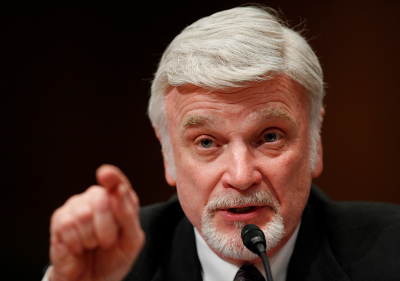
Trees dominate the skyline on a cold winter morning at Lake Manawa, Iowa, in front of the MidAmerican Energy power plant, Friday, Nov. 22, 2013. (AP Photo/Nati Harnik)
A topic that comes up periodically here on Coal Tattoo is why the U.S. should do anything about its greenhouse gas emissions absent an international agreement that includes all nations. Well, NPR, via WFPL, had an interesting piece on that called, “What’s In it for U.S. to Cut Greenhouse Gas Emissions.” It explains:
… If you ask Daniel Kammen, it’s a goal within reach. He’s a professor of energy and nuclear engineering at the Energy and Resources Group at Cal, and has an office just down the hill from Wolfram’s.
“China already has a carbon price; the U.S. does not,” Kammen points out, arguing that the world’s largest emitter isn’t ignoring climate change. That price is paid, one way or another, by companies that emit carbon dioxide.
It’s a relatively small amount of money — not nearly enough to stop the rapid increase in emissions from China. But China has other motivations to reduce emissions — starting with its toxic air.
“China is already paying a very high price for its fuel diet, and sees every motivation to ramp that amount of pollution down,” Kammen says. “That’s why China has become the world’s leader in production of solar panels, wind turbines and batteries for electric vehicles.”
Those technologies are still dwarfed by fossil fuels, but China is at least positioned for a transition, Kammen says.
And:
Across San Francisco Bay, Stanford University’s Sally Benson also sees a rationale for cleaning up U.S. emissions, even as China and other countries are making the problem worse.
“Certainly you do it for the good of the world, but you also do it for risk management,” says Benson, who directs the Global Climate and Energy Project at Stanford. Benson is referring to both economic and physical risk.
“I think there will come a day,” she says, “when it will become so clear that we need to do this right away, that the countries that haven’t prepared themselves really put themselves at much greater economic risk.”
The piece continues:
Finally, we posed the question to Chris Field, an environmental biologist who directs the Carnegie Institution for Science’s Department of Global Ecology, also on the Stanford campus.
Field argues that the United States can find ways to act that aren’t simply unilateral. If the U.S. gets the structure right, its strategy could actually shape what happens in the rest of the world, he says.
For example, the price of a product should reflect its environmental cost, Field says. That way, any buyer would help pay for the small incremental damage caused by the carbon dioxide that ended up in the atmosphere when the product was made.
The U.S. could impose this price unilaterally on domestic products. If China doesn’t also add that to the price of, say, an iPhone made in China, the U.S. could add the carbon fee with a tax at the border — and that money would go into the U.S. Treasury.
But Field also makes a more philosophical argument, one based on doing the right thing.
“Personally,” he says, “I believe that we are close to an era where if a country wants to be regarded as a leading country on the international scene, [its leaders] will recognize that this is one of the things you need to do.”
Meanwhile, the coal industry didn’t take too kindly to those remarks about changing and the future from U.N. climate chief Christiana Figueres. The Guardian reported:
The head of the World Coal Association (WCA) has accused UN climate chief Christiana Figueres of ‘ignoring reality’, following her call to the coal industry to invest in more efficient technologies.
In an interview, World Coal chief executive Milton Catelin told RTCC that Figueres’ lack of expertise in the mining and energy sectors meant she “misses some of the fundamentals about the energy sector”.
He was responding to a speech Figueres made to a ‘Climate and Coal Summit’ on the sidelines of UN negotiations in Warsaw two weeks ago, where she told the audience that “coal must change rapidly and dramatically for everyone’s sake.”
But as the New York Times reported, not everyone in the business world is so upset about the prospect of putting a price on carbon:
More than two dozen of the nation’s biggest corporations, including the five major oil companies, are planning their future growth on the expectation that the government will force them to pay a price for carbon pollution as a way to control global warming.
The development is a striking departure from conservative orthodoxy and a reflection of growing divisions between the Republican Party and its business supporters.
A new report by the environmental data company CDP has found that at least 29 companies, some with close ties to Republicans, including ExxonMobil, Walmart and American Electric Power, are incorporating a price on carbon into their long-term financial plans.
Both supporters and opponents of action to fight global warming say the development is significant because businesses that chart a financial course to make money in a carbon-constrained future could be more inclined to support policies that address climate change.
Continue reading…


 Subscribe to the Coal Tattoo
Subscribe to the Coal Tattoo

























